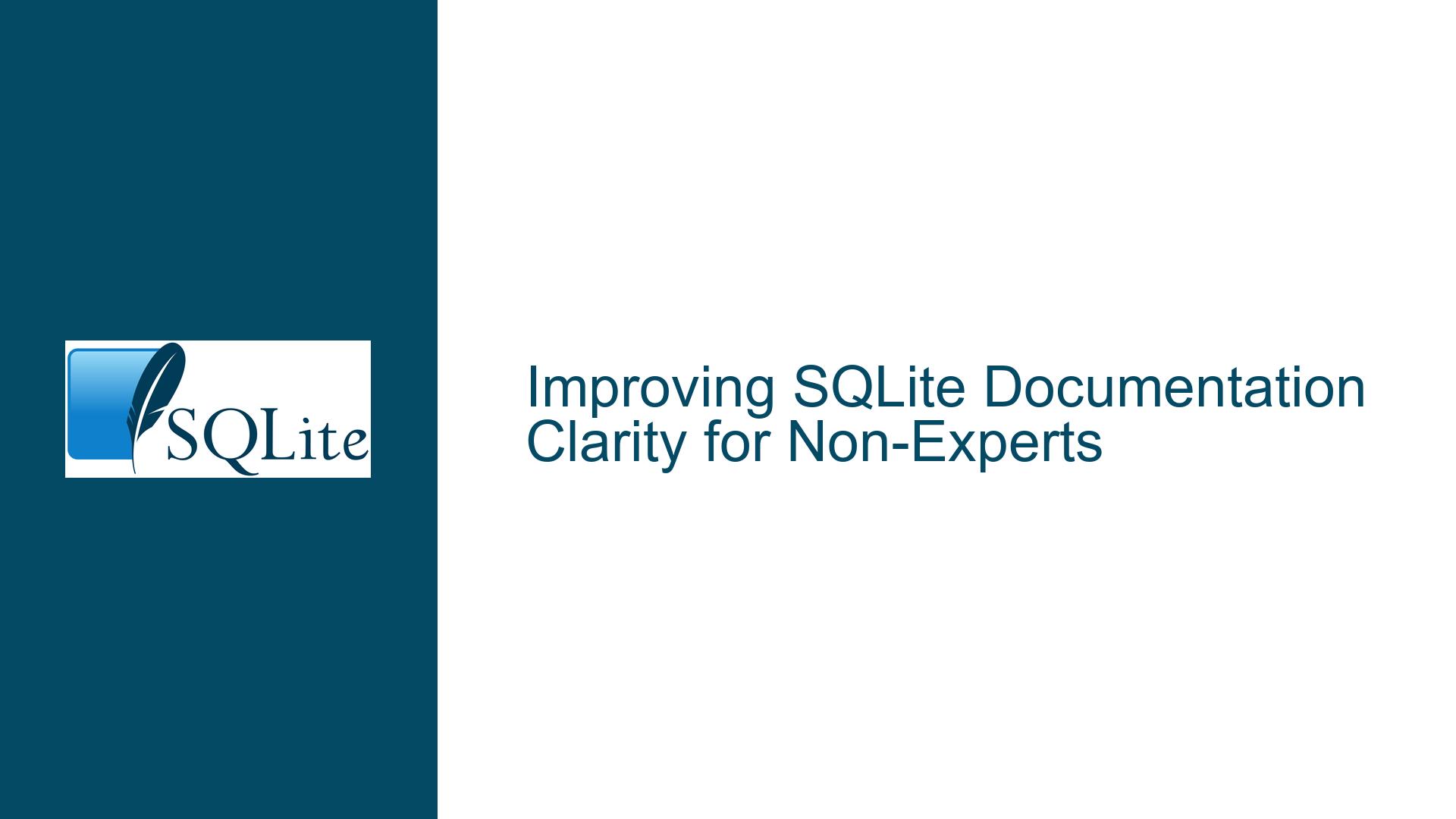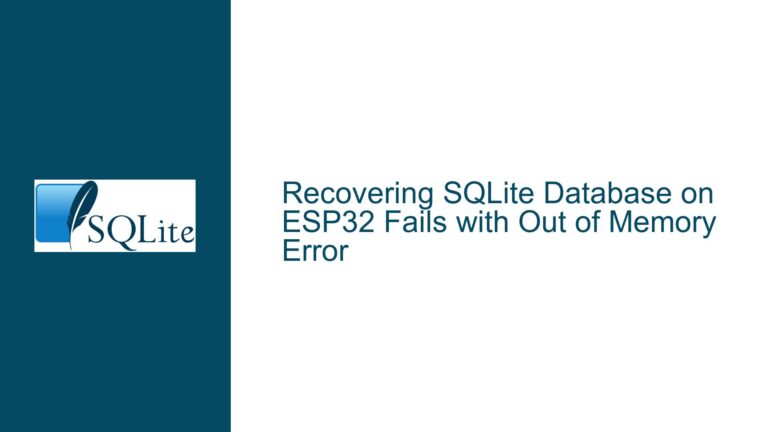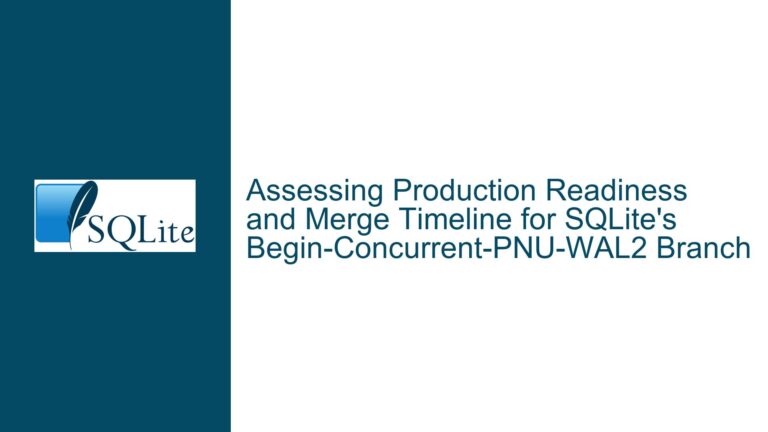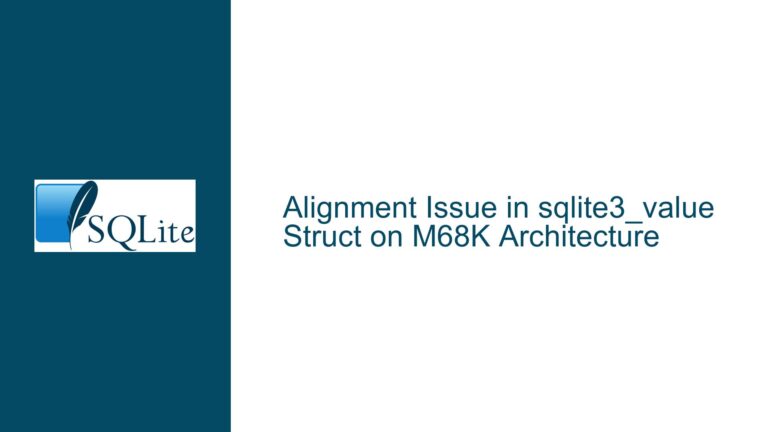Improving SQLite Documentation Clarity for Non-Experts
Understanding the Challenges with SQLite Documentation for Non-Experts
The SQLite documentation, while comprehensive and technically accurate, often assumes a level of expertise that may not align with the experience of many users. This disconnect can lead to confusion, particularly for those who are not deeply familiar with C programming or the intricacies of SQLite’s internal mechanisms. The primary issues revolve around undefined terms, lack of concrete examples, overly complex sentence structures, and an assumption of prior knowledge. These challenges can make it difficult for users to effectively utilize SQLite’s features, especially when working with extensions or the C API.
One of the most common pain points is the use of technical jargon without sufficient explanation or linking to relevant sections. For instance, terms like "zProc" or "nonstandard_entry_point" are used in the documentation without clear definitions or examples, leaving users to decipher their meanings on their own. Additionally, the documentation often lacks practical examples that illustrate how to use specific functions or commands, which can be particularly frustrating for users who are trying to apply these concepts in real-world scenarios.
The complexity of the sentences used in the documentation further exacerbates the issue. Long, convoluted sentences can be difficult to parse, especially for non-native English speakers or those who are not accustomed to technical writing. This can lead to misunderstandings or misinterpretations of the material, ultimately hindering the user’s ability to effectively use SQLite.
Identifying the Root Causes of Documentation Confusion
The root causes of the confusion stem from several factors, including the target audience of the documentation, the structure of the documentation, and the level of detail provided. The SQLite documentation is primarily written for C programmers who have a deep understanding of the language and its conventions. This assumption of expertise can alienate users who are not as familiar with C or who are new to SQLite.
Another contributing factor is the lack of cross-referencing within the documentation. While some terms and functions are linked to their respective pages, others are not, leaving users to search for definitions on their own. This can be particularly challenging when dealing with terms that are not commonly used outside of SQLite or when the documentation does not provide clear explanations.
The absence of practical examples is another significant issue. While the documentation provides detailed descriptions of functions and commands, it often lacks concrete examples that demonstrate how to use these features in real-world scenarios. This can make it difficult for users to understand how to apply the information provided in the documentation to their own projects.
Finally, the complexity of the sentences used in the documentation can make it difficult for users to follow along. Long, technical sentences can be hard to parse, especially for those who are not accustomed to reading technical documentation. This can lead to misunderstandings or misinterpretations of the material, ultimately hindering the user’s ability to effectively use SQLite.
Strategies for Enhancing SQLite Documentation Clarity
To address these issues, several strategies can be employed to improve the clarity and accessibility of the SQLite documentation. These strategies include providing clear definitions and examples, simplifying sentence structures, and ensuring that the documentation is accessible to users with varying levels of expertise.
One of the most effective ways to improve the documentation is to provide clear definitions for all technical terms and concepts. This can be achieved by either including definitions directly in the text or by linking to relevant sections where the terms are explained in detail. For example, when discussing the "zProc" parameter in the context of the sqlite3_load_extension() function, the documentation should provide a clear explanation of what "zProc" represents and how it is used. Additionally, the documentation should include examples that illustrate how to use the sqlite3_load_extension() function with different parameters, including cases where a nonstandard entry point is required.
Another important strategy is to simplify the sentence structures used in the documentation. This can be achieved by breaking down long, complex sentences into shorter, more manageable ones. For example, instead of writing a single, lengthy sentence that covers multiple concepts, the documentation should use shorter sentences that focus on one idea at a time. This will make it easier for users to follow along and understand the material.
In addition to simplifying sentence structures, the documentation should also include more practical examples that demonstrate how to use SQLite’s features in real-world scenarios. These examples should be concrete and specific, providing users with a clear understanding of how to apply the information provided in the documentation to their own projects. For instance, when discussing the .load command, the documentation should include examples that show how to load different types of extensions, including those with nonstandard entry points.
Finally, the documentation should be written with a broader audience in mind, taking into account the varying levels of expertise among users. This can be achieved by providing additional explanations and context for technical concepts, as well as by including more introductory material for users who are new to SQLite. By making the documentation more accessible to users with different levels of expertise, SQLite can ensure that its documentation is useful to a wider range of users.
Implementing Changes to Improve Documentation Clarity
To implement these changes, the SQLite documentation team should consider the following steps:
Review and Update Terminology: The documentation should be reviewed to identify any terms or concepts that are not clearly defined or explained. These terms should be either defined in the text or linked to relevant sections where they are explained in detail. For example, the term "zProc" should be clearly defined in the context of the
sqlite3_load_extension()function, and examples should be provided to illustrate its use.Simplify Sentence Structures: The documentation should be revised to simplify sentence structures, making it easier for users to follow along. This can be achieved by breaking down long, complex sentences into shorter, more manageable ones. For example, the sentence "The code template shown below will work just as well as a statically linked extension as it does as a run-time loadable extension except that you should give the entry point function ("sqlite3_extension_init") a different name to avoid name collisions if your application contains two or more extensions." could be rewritten as "The code template shown below will work just as well as a statically linked extension as it does as a run-time loadable extension. However, if your application contains two or more extensions, you should give the entry point function ("sqlite3_extension_init") a different name to avoid name collisions."
Add Practical Examples: The documentation should include more practical examples that demonstrate how to use SQLite’s features in real-world scenarios. These examples should be concrete and specific, providing users with a clear understanding of how to apply the information provided in the documentation to their own projects. For example, when discussing the
.loadcommand, the documentation should include examples that show how to load different types of extensions, including those with nonstandard entry points.Provide Introductory Material: The documentation should include more introductory material for users who are new to SQLite. This can be achieved by providing additional explanations and context for technical concepts, as well as by including more introductory material for users who are new to SQLite. By making the documentation more accessible to users with different levels of expertise, SQLite can ensure that its documentation is useful to a wider range of users.
Solicit Feedback from Users: The SQLite documentation team should actively solicit feedback from users to identify areas where the documentation can be improved. This can be achieved by conducting surveys, hosting user forums, or encouraging users to submit feedback directly through the SQLite website. By gathering feedback from users, the documentation team can gain valuable insights into how the documentation is being used and where improvements can be made.
Conclusion
Improving the clarity and accessibility of the SQLite documentation is essential for ensuring that users can effectively utilize SQLite’s features. By providing clear definitions and examples, simplifying sentence structures, and ensuring that the documentation is accessible to users with varying levels of expertise, SQLite can make its documentation more useful and user-friendly. Implementing these changes will require a concerted effort from the SQLite documentation team, but the benefits of a more accessible and understandable documentation will be well worth the effort. Ultimately, by making the documentation more accessible to a wider range of users, SQLite can ensure that its powerful features are available to all who need them.






